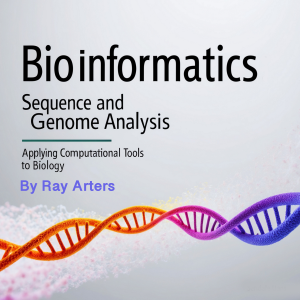

Bioinformatics
Ray Arters
This audiobook is narrated by a digital voice.
The transformation of biology from a purely descriptive science into a data-driven, computational discipline represents one of the most profound shifts in scientific history. Bioinformatics emerged at the intersection of biology, computer science, and statistics to address the exponential growth of biological data that began in the late 20th century. This interdisciplinary field has become indispensable for modern biological research, enabling scientists to store, analyze, and interpret vast amounts of genetic, protein, and cellular information that would be impossible to process using traditional methods.
The conceptual foundation of bioinformatics rests on the recognition that biological systems can be understood as information processing networks. DNA sequences encode instructions for building and operating living organisms, protein structures determine molecular function, and cellular networks process signals and make decisions. This information-centric view of biology naturally lends itself to computational analysis, where biological problems can be translated into computational challenges that leverage the power of modern computing.
Historical development of bioinformatics began with the first protein sequences determined in the 1950s, when Frederick Sanger sequenced insulin and established that proteins have defined, reproducible structures. The accumulation of protein sequence data led to the creation of the first biological databases and the development of algorithms for comparing sequences. The field accelerated dramatically with the advent of DNA sequencing technologies in the 1970s and 1980s, which produced genetic information at unprecedented rates.
Duration - 1h 4m.
Author - Ray Arters.
Narrator - Digital Voice Archie G.
Published Date - Friday, 24 January 2025.
Copyright - © 2025 Ray Arters ©.
Location:
United States
Description:
This audiobook is narrated by a digital voice. The transformation of biology from a purely descriptive science into a data-driven, computational discipline represents one of the most profound shifts in scientific history. Bioinformatics emerged at the intersection of biology, computer science, and statistics to address the exponential growth of biological data that began in the late 20th century. This interdisciplinary field has become indispensable for modern biological research, enabling scientists to store, analyze, and interpret vast amounts of genetic, protein, and cellular information that would be impossible to process using traditional methods. The conceptual foundation of bioinformatics rests on the recognition that biological systems can be understood as information processing networks. DNA sequences encode instructions for building and operating living organisms, protein structures determine molecular function, and cellular networks process signals and make decisions. This information-centric view of biology naturally lends itself to computational analysis, where biological problems can be translated into computational challenges that leverage the power of modern computing. Historical development of bioinformatics began with the first protein sequences determined in the 1950s, when Frederick Sanger sequenced insulin and established that proteins have defined, reproducible structures. The accumulation of protein sequence data led to the creation of the first biological databases and the development of algorithms for comparing sequences. The field accelerated dramatically with the advent of DNA sequencing technologies in the 1970s and 1980s, which produced genetic information at unprecedented rates. Duration - 1h 4m. Author - Ray Arters. Narrator - Digital Voice Archie G. Published Date - Friday, 24 January 2025. Copyright - © 2025 Ray Arters ©.
Language:
English
Bioinformatics
Duration:01:04:06